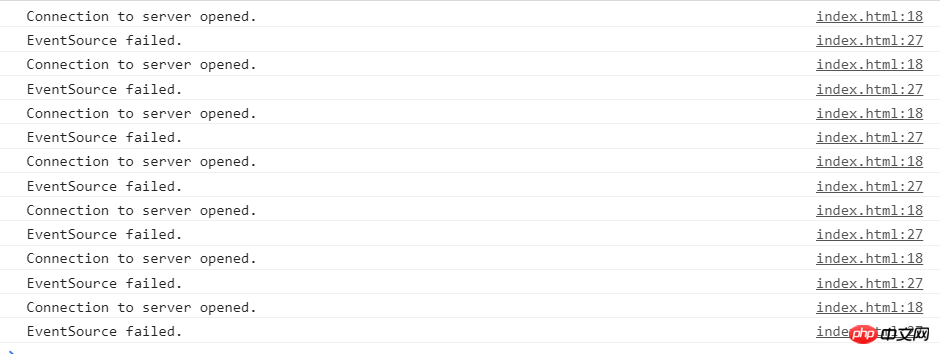Introduction to EventSource sent by sse server in html5
This article mainly introduces a brief introduction to the EventSource of sse server-sent events in HTML5. It has a certain reference value. Those who are interested can learn more
Preface
I talked about the big data screen in the previous article, and the data in it is updated from time to time. There are also stock data that are updated from time to time, Facebook/Twitter updates, valuation updates, new blog posts, event results, etc., all require data to be updated from time to time. Before, we usually requested the server to see if there was any data that could be updated. HTML5 provides the Server-Sent Events method, which sends events through the server and updates can arrive automatically.
Usage of Server-Sent Events
Server-Sent Events is very simple to use. It accepts server-side messages through the EventSource object. There are the following events:
onopen When the connection to the server is opened
onmessage When a message is received
onerror When an error occurs
Detect Server-Sent event support
if(typeof(EventSource)!=="undefined")
{
// 浏览器支持 Server-Sent
// 一些代码.....
}
else
{
// 浏览器不支持 Server-Sent..
}Receive Server-Sent event notification
var source=new EventSource("haorooms_sse.php");
source.onmessage=function(event)
{
document.getElementById("result").innerHTML+=event.data + "<br>";
};Server-side code example
<?php
header('Content-Type: text/event-stream');
header('Cache-Control: no-cache');
$time = date('r');
echo "data: The server time is: {$time}\n\n";
flush();
?>Add
if(typeof(EventSource)!=="undefined")
{
var source=new EventSource("server.php");
source.onopen=function()
{
console.log("Connection to server opened.");
};
source.onmessage=function(event)
{
document.getElementById("result").innerHTML+=event.data + "<br>";
};
source.onerror=function()
{
console.log("EventSource failed.");
};
}
else
{
document.getElementById("result").innerHTML="抱歉,你的浏览器不支持 server-sent 事件...";
}to both link events and error events. We will find that the console prints as follows:

Keep entering links and errors, please click for details
That’s because the php code is just a simple echo and does not output continuously. We will improve the above php code as follows
<?php
header('Content-Type: text/event-stream');
header('Cache-Control: no-cache');
$time = date('r');
$i = 0;
$c = $i + 100;
while (++$i < $c) {
echo "id: " . $i . "\n";
echo "data: " . $time. ";\n\n";
ob_flush();
flush();
sleep(1);
}
?>Then there will be no more errors!
IE browser compatible solution
We know that IE browser does not support EventSource, there are the following solutions:
Introduction
eventsource.min.js
can be solved perfectly. You can check its github address: https://github.com/Yaffle/EventSource. It is also very convenient to use it with nodejs. Just
npm install event-source-polyfill
.
The above is the detailed content of Introduction to EventSource sent by sse server in html5. For more information, please follow other related articles on the PHP Chinese website!

Hot AI Tools

Undresser.AI Undress
AI-powered app for creating realistic nude photos

AI Clothes Remover
Online AI tool for removing clothes from photos.

Undress AI Tool
Undress images for free

Clothoff.io
AI clothes remover

AI Hentai Generator
Generate AI Hentai for free.

Hot Article

Hot Tools

Notepad++7.3.1
Easy-to-use and free code editor

SublimeText3 Chinese version
Chinese version, very easy to use

Zend Studio 13.0.1
Powerful PHP integrated development environment

Dreamweaver CS6
Visual web development tools

SublimeText3 Mac version
God-level code editing software (SublimeText3)

Hot Topics
 1377
1377
 52
52
 Table Border in HTML
Sep 04, 2024 pm 04:49 PM
Table Border in HTML
Sep 04, 2024 pm 04:49 PM
Guide to Table Border in HTML. Here we discuss multiple ways for defining table-border with examples of the Table Border in HTML.
 HTML margin-left
Sep 04, 2024 pm 04:48 PM
HTML margin-left
Sep 04, 2024 pm 04:48 PM
Guide to HTML margin-left. Here we discuss a brief overview on HTML margin-left and its Examples along with its Code Implementation.
 Nested Table in HTML
Sep 04, 2024 pm 04:49 PM
Nested Table in HTML
Sep 04, 2024 pm 04:49 PM
This is a guide to Nested Table in HTML. Here we discuss how to create a table within the table along with the respective examples.
 HTML Table Layout
Sep 04, 2024 pm 04:54 PM
HTML Table Layout
Sep 04, 2024 pm 04:54 PM
Guide to HTML Table Layout. Here we discuss the Values of HTML Table Layout along with the examples and outputs n detail.
 HTML Input Placeholder
Sep 04, 2024 pm 04:54 PM
HTML Input Placeholder
Sep 04, 2024 pm 04:54 PM
Guide to HTML Input Placeholder. Here we discuss the Examples of HTML Input Placeholder along with the codes and outputs.
 HTML Ordered List
Sep 04, 2024 pm 04:43 PM
HTML Ordered List
Sep 04, 2024 pm 04:43 PM
Guide to the HTML Ordered List. Here we also discuss introduction of HTML Ordered list and types along with their example respectively
 Moving Text in HTML
Sep 04, 2024 pm 04:45 PM
Moving Text in HTML
Sep 04, 2024 pm 04:45 PM
Guide to Moving Text in HTML. Here we discuss an introduction, how marquee tag work with syntax and examples to implement.
 HTML onclick Button
Sep 04, 2024 pm 04:49 PM
HTML onclick Button
Sep 04, 2024 pm 04:49 PM
Guide to HTML onclick Button. Here we discuss their introduction, working, examples and onclick Event in various events respectively.




